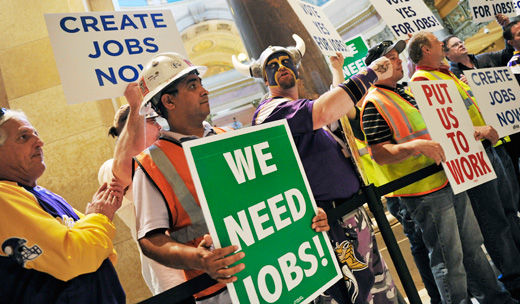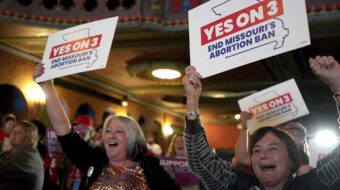
ST. PAUL, Minn. (PAI) – With Republicans in control of both houses of the Minnesota legislature for the first time in 38 years, they unveiled an unprecedented attack on worker rights and protections, including the granddaddy of all anti-union legislation: “Right to work.”
But with strong support of Democratic-Farmer-Labor Gov. Mark Dayton, organized labor succeeded in stopping most of the repressive legislation and pushing lawmakers to boost jobs through infrastructure bonding and Minnesota Vikings stadium bills.
But union leaders said the session represented a lost opportunity to revive Minnesota’s economy – and they’ll put the record of state lawmakers before union members when they go to the polls this fall.
“The attacks on middle-class workers this legislative session have been relentless,” said Julie Schnell, president of SEIU Healthcare Minnesota.
“Over the coming months, Minnesota’s union members will be carefully examining whether their legislators stood up for working people over the last two years,” said Shar Knutson, president of the Minnesota AFL-CIO.
The year began with clear signals that Republicans would try to push through a measure to amend the state constitution to make Minnesota a “Right to Work” state.
Part of the national agenda for corporate America since the 1950s, Right to Work laws allow workers covered by union contracts to avoid paying their fair share of the costs of representation, yet still enjoy the benefits of the contract.
The Right to Work law weakens unions, making it harder for them to advocate for their members and the public. Union members, including firefighters and nurses, testified that through their unions, they are able to negotiate for life-saving equipment and better patient care.
Ultimately, a bipartisan group of lawmakers stalled the legislation and prevented it from coming to a vote. Numerous other bills that continued divisive, Wisconsin-style attacks on collective bargaining were also stopped – some by Dayton’s veto pen.
Unions are opposing two proposed amendments to the Minnesota constitution that will be on the ballot this fall: A photo ID requirement that would limit voting rights, passed by the legislature this year, and a ban on same-sex marriage, approved by lawmakers last year.
These amendments, also part of the national Right Wing agenda, “Would shred the very fabric of our state’s diversity and proud inclusivity that makes Minnesota a desirable and livable state that’s strong economically, socially and culturally,” said Javier Morillo, president of SEIU Local 26.
The final days of the session, which ended in early May, focused on approval of an infrastructure bonding bill and legislation to fund a new stadium for the Minnesota Vikings – both high priorities for Building Trades unions, some of whom have 30% of their members out of work.
“Between a jobs and infrastructure bill and a new stadium in downtown Minneapolis, tens of thousands of Minnesotans will soon be going back to work in good-paying, family sustaining jobs,” said Knutson.
However, unions said more was needed to boost the state’s sluggish economy. SEIU said the bonding bill was “a very watered-down version that will create fewer jobs than hoped for and improve less of Minnesota’s infrastructure than our state needs.”
While failing to create jobs and continuing to borrow money from school districts to balance the state budget, Republican legislators again put forth a bill to cut corporate taxes. Dayton vetoed it.
Public school teachers were a particular target, with more than 20 bills attacking public education.
“None of them responsibly addressed the most pressing needs of our students, including repaying the state’s $2 billion IOU to its schools, closing the achievement gap and developing a sustainable funding system for the future,” said Tom Dooher, president of Education Minnesota, the state’s joint AFT-NEA affiliate.
“Instead, we saw bills that would raise the health insurance costs for educators and their districts, put corporate tax breaks ahead of repaying the debt to our schools and impose new regulations for teacher layoffs,” he added.
Other measures would have stripped teachers of their collective bargaining and seniority rights. None became law, in large part because of vetoes by Dayton.
“Our special thanks go to Gov. Dayton, who said in February that education policy shouldn’t be a political ploy. He meant it,” said Dooher.
Union leaders were unanimous in their praise of Dayton, who repeatedly called on lawmakers to focus on jobs – not attacks on workers. Unions also said members turned out in impressive numbers, participating in numerous rallies and lobby days at the Capitol and phoning and e-mailing lawmakers on the issues. A March 12 demonstration against Right to Work, which drew more than 1,600 people, was one of the largest union actions at the Capitol in recent memory.
The labor movement hopes that type of activism will translate into power at the polls in November, when the entire legislature, eight Minnesota U.S. House seats, a U.S. Senate position and the presidency of the United States will be at stake.
“When the legislature convenes in January, Minnesota will face another multi-billion dollar revenue shortfall,” said Knutson. “Minnesotans will have an opportunity to elect legislators who will stand up for working people instead of shutting down state government to protect corporate special interests.”
Barb Kucera is editor of Workday Minnesota, where this article originally appeared. Photo: Minnesota Vikings supporters and building trades workers rally outside the Minnesota House in support of a new stadium for the Vikings NFL football team, May 7, in St. Paul, Minn. Jim Mone/AP












Comments